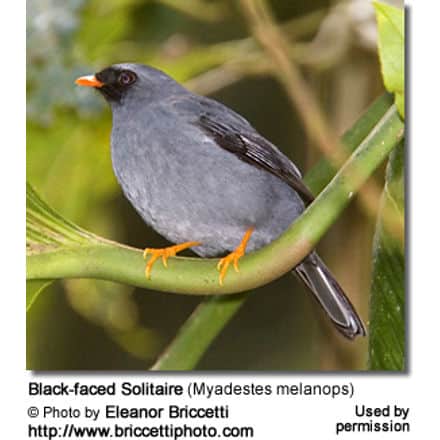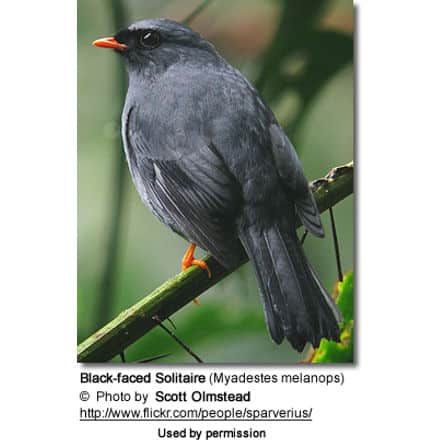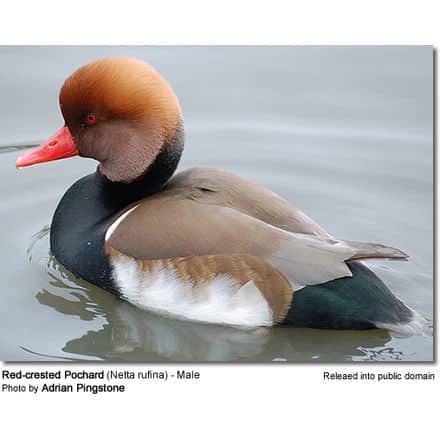Black-faced Solitaires
The Black-faced Solitaires (Myadestes melanops) are song birds found in the Central American countries of Costa Rica and Panama.
Within their range, these thrushes are well known for the beautiful songs produced by both males and females.
Their popularity as cage birds has caused their numbers to decline as so many of them were trapped for the cage trade.
Another contributing factor continues to be the destruction of their forest habitats.
However, their numbers remain stable in protected areas.
Their close relatives – the more southern Varied Solitaires (Myadestes coloratus) and the South American Andean Solitaires (Myadestes ralloides) – have similar physical attributes and vocalizations.
Hence some earlier authorities felt that these species should be considered conspecific (one and the same species); however, the differences in plumage details supports their treatments as separate species.
Distribution / Habitat
Black-faced Solitaires occur naturally in the mountains of Costa Rica and western Panama, where they are most numerous in western Chiriquí.
Within their range, they are generally found at elevations from In Costa Rica, they are found at higher elevations, typically from about 3,100 to 9,000 feet (~ 950 to 2,750 meters). In Panama, they are found from 2,500 to 10,000 feet (~750 to 3,000 meters).
After the breeding season which coincides with the wet season, populations found on the Caribbean slope move down to about 1500 feet (~ 450 meters) or even 330 feet (~ 100 meters).
They inhabit humid montane forests, particularly in areas with bamboo and a dense understory. They may visit pastures and other cultivated areas.
Outside the breeding season, they are often observed foraging in large, loose flocks.
Dynamic map of eBird sightings (View sightings and enter your own)
Description
Size
Black-faced Solitaires measure about 6.3 – 7.3 oz (16 – 18.5 cm) in length – including their tails; and they weigh between 1.1 – 1.2 oz (30 – 33 grams).
Plumage Details / Adults
- Plumage mostly slate grey
- Black forehead, face and chin
- Wings and tail are slate-edged black
- Underwing coverts are silvery-white (best seen in flight)
Other Physical Details
- Broad, yellow-orange bill
- Orange legs
Juvenile Description
- Buff streaks on the head and upperparts
- Distinct black forehead and face
- Below buff and brown mottling
Similar Species
In Costa Rica and western Panama, these birds are unlikely to be confused with any other species. However, similar species can be found further south …
- The Varied Solitaire (Myadestes coloratus):
- Range: Highlands of extreme eastern Panama and adjacent northwestern Colombia in Central America
- ID: Chestnut colored back and wings
- The Andean Solitaire (Myadestes ralloides):
- Range: Andes mountain range – from Venezuela south to Bolivia in South America
- ID: Plain grey face, chest and belly.
Diet / Feeding
The Black-faced Solitaires mostly feed on fruits (including palm fruits) and various berries. They also take seeds and, on occasion, insects.
Breeding / Nesting
Most breeding activities take place from April to June.
Their cup nests are constructed out of green mosses and liverworts. They are lined with stems of mosses and liverworts, as well as dark rootlets. Their nests are typically situated in the crevices of trees, rock crevices, or on concealed tree forks – about 3 – 16 feet (~ 1 – 5 meters) above the ground.
The average clutch consists of 2 – 3 pinkish-white eggs with rufous-brown blotches. The incubation period is about 12 – 13 days, and the young fledge 15 – 16 days later. Both parents feed and protect the young.
Calls / Vocalizations / Sounds / Recordings
Contact Calls: nasal ghank … liquid quirt … a throaty “rraou” … Alarm Call: buzzy “schwee“
Songs: whistled teedleedlee…tleedleeee…lee-dah…lee-dah … lee-doo
Alternate (Global) Names
Chinese: ???? … Czech: Les?ák / Skalnícek cernolící … Danish: Sortmasket Klarinetfugl … Dutch: Zwartmaskersolitaire … Finnish: Rosvorastuli … French: Solitaire à face noire, Solitaire masqué … German: Maskenklarino … Italian: Solitario faccianera … Japanese: zugurohitoritsugumi … Norwegian: Maskesolitærtrost … Polish: klarnetnik czarnolicy … Slovak: drozdovec maskový … Spanish: Clarín de Cara Negra, Solitario carinegro … Swedish: Masksolitär





